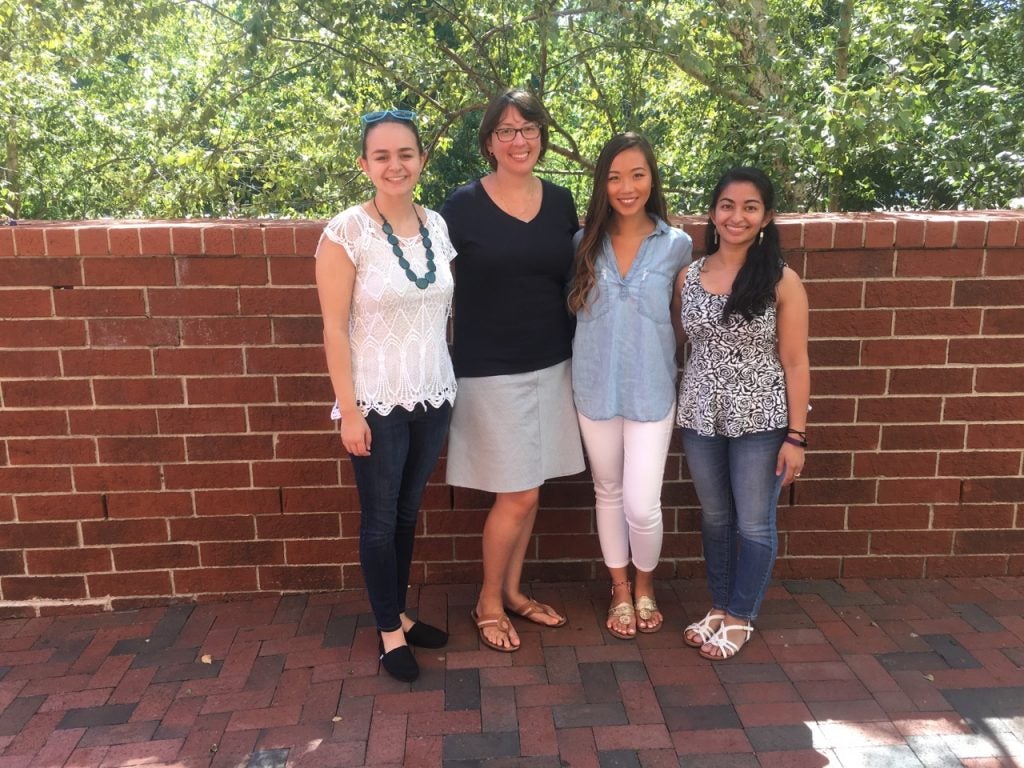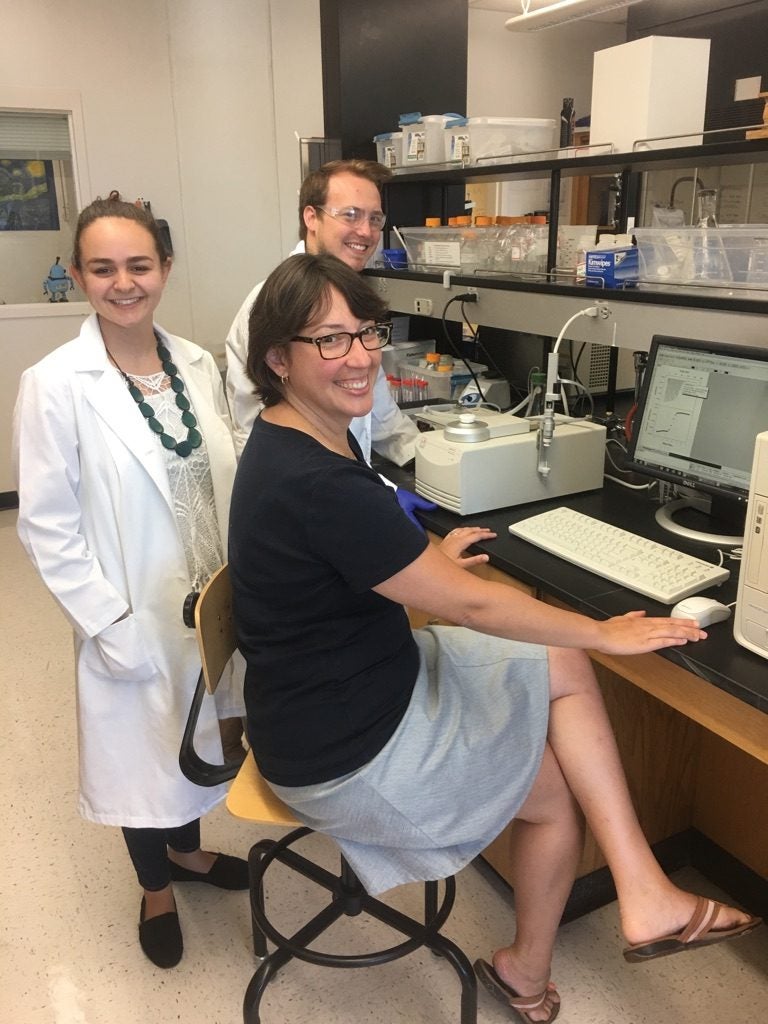ECU researchers studying Cadmium disruption of Calcium binding proteins
Researchers at East Carolina University are continuing to study a known toxin and its interaction with Human Cardiac Troponin C (HcTnC), whose normal binding structure with Calcium helps regulate the contraction and relaxation of the heart muscle. Any disruption of this binding may lead to a buildup of Calcium and numerous health issues, including blocked arteries, irregular heart rhythms and even death.

Pictured left to right: Caitlin Palmer, Dr. Anne Spuches, Katie Vang, Eshita Karnik. (Photos and images provided by Anne Spuches)
Dr. Anne Spuches, associate professor of chemistry, recently was awarded a three-year, $252,000 grant from the National Science Foundation to support her work on the project.
Along with fellow colleagues and undergraduate and graduate students in her lab, Spuches is researching calcium and cadmium interactions with EF-hand proteins. Specifically, they are examining how Cd(II) binds with HcTnC, preventing the crucial binding of Ca(II).
Spuches’ team consists of Drs. Toby Allen and Anthony Kennedy from the Department of Chemistry; Drs. Joseph Chalovich and Bill Angus (ret.), from the Brody School of Medicine Department of Biochemistry; Dr. Barbara Lyons, from New Mexico State University; former ECU graduate students Lindsay Fulcher and Rachel Johnson; doctoral student Katherine Buddo; and graduate students Eshita Karnick and Katie Vang.
Fulcher was the first student to work with Spuches on cadmium research and performed intense ITC studies to determine the binding constant of metal to protein. She was able to learn how tightly cadmium was binding in comparison to calcium.
She said Spuches gave her the freedom to be creative, which allowed her to build a story that started from the molecular level and has the potential to develop into something that could help people.
“Working in Dr. Spuches lab taught me to always push to learn more and find a way to connect small pieces to a bigger picture,” said Fulcher. “That is where you find meaning and thus the motivation to help change the world through science and research.”
She referred to her experience as something she can use no matter where she goes and no matter what she is doing, saying it was a “soul-searching project.”
The research being performed by Spuches’ team will have multiple benefits, including filling a gap in the current literature regarding the binding of cadmium to other proteins that natively bind calcium.
“It is known that Cd(II) can disrupt Ca(II) signaling pathways but little else is known about the mechanisms of such interactions,” said Spuches.
Another benefit of the research is that it continues to enable students to conduct independent research in the field of bioinorganic chemistry, learning a multitude of techniques that will prepare them for careers in the pharmaceutical or biotechnology industries and making them competitive for PhD programs.
“I have really enjoyed working with Dr. Spuches,” said graduate student researcher Katie Vang. “What I enjoy most is seeing the experiments come to life in her lab. She has been working on this project for a long time and to actually be in the lab and see the raw experiments/data is quite rewarding.”
“Her passion has given me insight on the importance for research and what it can contribute to the world,” said Vang.
Ultimately, Spuches’ project may have important implications for how scientists view cadmium toxicity.
“Cadmium exposure and toxicity remain important environmental concerns in the U.S. and in North Carolina,” said Spuches. “Chronic Cd(II) exposure can result in numerous health problems, including cognitive impairment in children, low birth weights and preeclampsia in pregnant women, and cardiovascular disease in adults.”

The structure of cardiac troponin C regulatory domain with bound Cd(II) reveals a closed conformation and unique ion coordination. (Figures generated by Katherine Buddo and Lindsay Fulcher)
Currently, cadmium is found in cigarette smoke, paint and pesticides, which trickle down into drinking water and are often found in the food supply.
According to Spuches, there is some indication that cadmium also may increase the risks for diabetes and obesity.
This is the topic of a future study Spuches will conduct with Honors College undergraduate students Caitlin Palmer and Jacob Montgomery, and Drs. Lisa Domico and Walter Pories at the ECU Brody School of Medicine, who will examine pesticides and metals found in patients from eastern North Carolina, and their correlation with diabetes and obesity.
The results of Spuches’ research may allow people to make more informed decisions in the future about how to avoid or limit their exposure to toxic metals in the environment, decreasing their potential health risks.
-by Lacey L. Gray, University Communications

